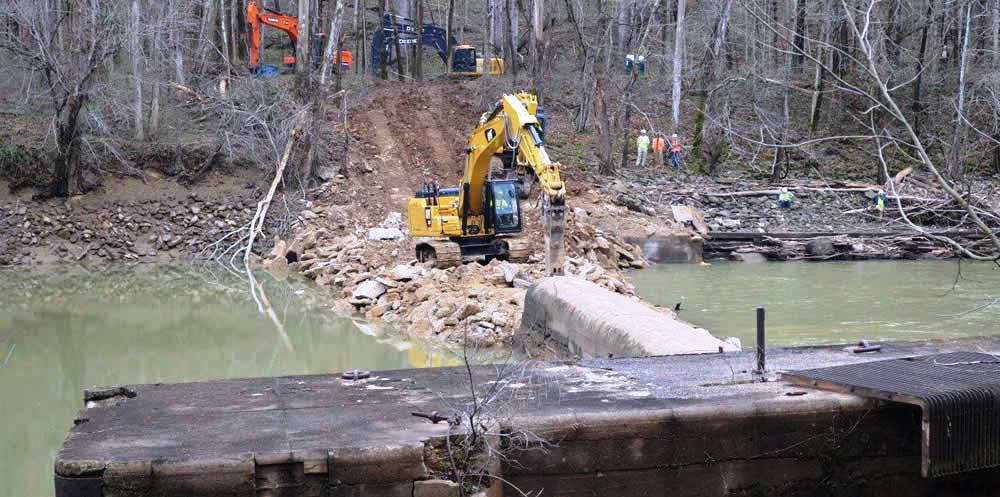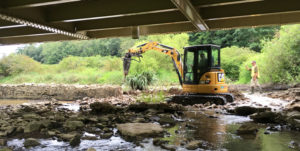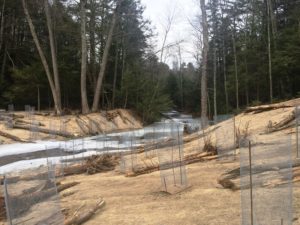In the midst of all the challenges 2017 saw for rivers and clean water, it was a record year for removing outdated, unsafe dams in the United States.
Eighty-six dams were torn down in 2017, beating the previous high number of 78 dams in 2014. Communities in 21 states, working in partnership with non-profit organizations and state and federal agencies, removed the dams to reconnect more than 550 miles of streams.
Dams were removed in the following states: Alaska, California, Connecticut, Iowa, Indiana, Kentucky, Massachusetts, Maine, Michigan, Minnesota, Nevada, New Hampshire, New Jersey, North Carolina, Ohio, Oregon, Pennsylvania, Tennessee, Vermont, Washington, and Wisconsin.
In 2017, Pennsylvania had the highest number of removals for the fifteenth year in a row. The top three states removing outdated dams in 2017 were:
- Pennsylvania – 16 dams removed;
- California – 10 dams removed;
- Massachusetts– 9 dams removed.
American Rivers is the only organization maintaining a record of dam removals in the United States. The database includes information on 1,492 dams that have been removed across the country since 1912. Most of those dams (1,275) were removed in the past 30 years.
While the Trump administration made 2017 a tough year for river health and clean water, it was a damn good year for dam removal.
American Rivers played a role in 14 of the dam removals on this year’s list. The list includes all known dam removals, regardless of the extent of American Rivers’ involvement.
Factors that contributed to the record number of dams removed in 2017 include increased awareness about the benefits of removing outdated, unsafe dams; efforts by American Rivers and others to train organizations and increase capacity to manage dam removal projects; and the cost of maintaining aging dams, which pose liability and safety hazards for their owners.
The American Society of Civil Engineers gives the nation’s dams a D grade in its report card on the nation’s infrastructure. One of the most cost-effective ways to deal with outdated, unsafe dams is to remove them. When a dam is removed, a river can flow naturally, which can have benefits for water supply and flood protection.
2017 DAM REMOVALS INCLUDED:
LOCK AND DAM NO. 6 ON GREEN RIVER IN KENTUCKY
In recent years, the U.S. Army Corps of Engineers’ Louisville District undertook an economic assessment of navigation dams on the Green and Barren rivers in Kentucky, and received Congressional approval to de-authorize (i.e., retire) five little-used locks and dams. Lock and Dam No. 6 was quickly removed from the Green River by the U.S. Fish and Wildlife Service (USFWS) – utilizing a construction crew that has successfully removed several dams throughout the southeast – in April 2017, due to its deteriorated condition and safety hazard.
Other project partners included: Kentucky Department of Fish and Wildlife Resources, Mammoth Cave National Park, The Nature Conservancy and Kentucky Waterways Alliance. In addition to the project improving habitat for fish, mussels and invertebrates, the dam’s impoundment was filling a portion of Mammoth Cave National Park with water and sediment, and that part of the caves will now be accessible for important archaeological study. The project is precedent-setting for removing uneconomical, expensive federal navigation infrastructure and for the federal partnership between the Army Corps and USFWS.
LOWER EKLUTNA RIVER DAM ON EKLUTNA RIVER IN ARKANSAS
Originally built to provide hydropower, but no longer in use, the Lower Eklutna River Dam was removed in October 2017 in one of Alaska’s most ambitious habitat restoration projects ever.
The Eklutna Native Corporation and the Native Village of Eklutna partnered with The Conservation Fund to work within a brief construction window in a 300-foot deep steep-walled canyon to open seven miles of the Eklutna River for salmon migration.
This project has provided construction work for the local community, boosting the economy and helping to restore salmon runs that are vital for cultural heritage and sustenance.
LOWER, MIDDLE & UPPER POND DAMS ON HAMANT BROOK IN MASSACHUSETTS
Three dams on Hamant Brook in Massachusetts were removed in Fall 2017 to allow native trout and endangered turtles access to important habitat. Hamant Brook runs through the Leadmine Conservation Area – 880 acres of protected municipal conservation land.
The project includes work to improve public access to the protected lands, while removing a public safety hazard and improving habitat for fish and wildlife.
The Hamant Brook Restoration Project is supported by the landowners (Town of Sturbridge and Old Sturbridge Village), in partnership with the Massachusetts Division of Fisheries and Wildlife, American Rivers, and the Massachusetts Division of Ecological Restoration.
BOARDMAN DAM ON BOARDMAN RIVER IN MICHIGAN
The Boardman River Dam removal is part of a larger restoration effort to address four barriers along the Boardman River in Michigan. This project not only removed an impediment to fish passage, but also improved a river crossing for local residents.
Previously, the Brown Bridge Dam was removed in 2013, and plans are in place to remove Sabin Dam and modify Union Street Dam in the near future. The largest river restoration project in Michigan’s history, collectively the project will restore more than three river miles of native coldwater fish habitat, more than 250 acres of wetlands and nearly 60 acres of upland habitat.
Featured photo (courtesy of The Nature Conservancy) shows the removal of the Green River Dam.
The original version of this article by Jessie Thomas-Blate originally appeared here on the American River website. Reprinted with permission.
See American Rivers’ full list of 2017 dam removals.
See American Rivers’ database of all u.s. dam removals since 1916.
See interactive map of all known dam removals in the United States since 1916.



